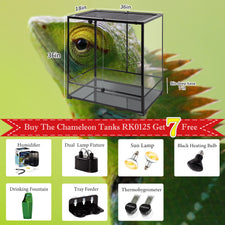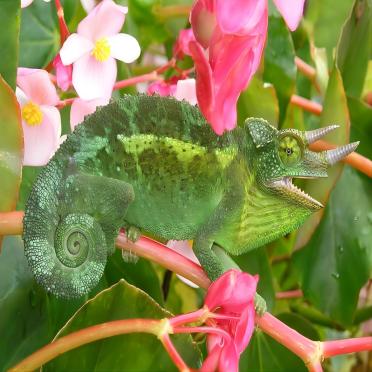Animal lovers are many. While most of us love dogs and cats, there are others who gel well with special creatures like reptiles and amphibians. Whatever the case, pets are very close to us, and we want to give them all care, warmth, and affection.
One such adorable and lovely pet is - the Jackson Chameleon.

If you plan to bring in a Jackson chameleon as your pet, this page is just for you.
Read on to delve into the care sheet which offers all the information on their characteristics, behavior, housing needs, heating and lighting requirements, feeding guidelines and health issues, and treatment options.
Let’s get started.
Everything You Need to Know About Your Dear Reptile Friend - Jackson Chameleon
It’s always recommended that you know the behaviors, characteristics, and other features associated with any animal before you bring them as your pet. This knowledge would not only acquaint you better but even play a significant role in your raising them well.
Let’s understand the key characteristics/attributes of your new reptile friend, the Jackson Chameleon.
They are typical in colors
As young creatures, they are usually brown in color while they turn green on maturing. Males are flanked by blue, with yellow on their head and backs. Females are more on the greener shades and may have a slight reddish hue.
They are easily recognized
The characteristic that makes these animals distinct is the three horns on their faces. They have a rostral horn on the nose and two other horns, one beneath each eye. The unique attribute is that while these horns are prominent in males, the females have no horns at all.
They are quite long
While males grow 8-10” long, females are typically 7-8”. In any case, they are well-grown in length.
They have an average lifespan
Usually, both males and females live for 2-5+ years if they are taken care of properly.
They have long spines
Both males and females are characterized by long spines running along their backs.
They are territorial in nature
Chameleons are highly possessive of their territories and could get aggressive if intruded. It’s advisable to house them individually, or they may engage in fighting.
Also, don’t house them with species of other reptiles, as they tend to become irritated.
Care Sheet for starters - Jackson Chameleon
Housing needs
Chameleons are arboreal creatures making it essential to have vertically oriented chameleon enclosures so that they climb around and keep themselves active. Usually, depending on their size, they need enclosures of a minimum size of 24 inches length x 24 inches width x 36 inches height for one adult. It’s best to offer them a lively aquarium or meshed or netted habitat with lids provided to prevent escape.
Habitat
One of the key attributes of Jackson chameleons is that they prefer to remain in hiding. Therefore, it is recommended to have a lot of bushes, shrubs, and branches in their enclosure so that they can enjoy their privacy. Besides, you must create branches and vines of varying widths and thicknesses so that they can get a grip and climb easily.
Substrate
As these animals spend very little time on the ground, you don’t require much substrate. However, as chameleons thrive in highly humid conditions, substrates make the cleaning of molds, etc., easier. Never use substrates like sand, gravel, or mulch in chameleon habitats, as they irk these creatures. Instead, resort to paper-based substrates or consult a vet.
Heating and Lighting
With regard to temperatures, chameleons are ectotherems meaning they possess the ability to adjust their body temperatures according to their surroundings. There are, however, some recommended temperature ranges ideal for the growth of chameleons. In the daytime, it ranges between 82-85 degrees F, while the nighttime temperatures should be around 55-60 degrees F.
You can use two thermometers - one in the warm zone and the other in the cool zone to monitor the temperatures. Heat sources like incandescent bulbs or such can be used to maintain warmth. Never use hot rocks or such materials that could significantly boost the temperatures. A best practice would be to attach a thermostat to your heating device so that you can easily regulate the temperatures.
For lighting requirements, Jackson chameleons need 10-12 hours of UVB exposure daily. This is essential because they require vitamin D to produce calcium in their bodies. Chameleons in meshed habitats must be kept in the sunlight for warmth and UVB exposure. Additionally, UVB lights must be switched off at night and changed every six months, depending on their power.
Humidity requirements
Jackson chameleons show the properties of shedding their skin. This is a crucial aspect of their life cycle and requires adequate humidity requirements. The process of shedding usually needs the chameleons to maintain humidity levels of 50-75%.
To keep the habitat cool and humid, you can use commercial drip systems or reptile foggers; however, do ensure that you clean the enclosure at least twice a month to ward off any microbial growth. Use a hygrometer or humidity gauge to monitor the levels. Another way to maintain humidity levels is to spray the enclosure or let the animal drink water.
Remember to keep the humidity requirements as recommended; they are critical for shedding and overall growth of chameleons.
Diet and Feeding Guidelines
Among other factors, a healthy and balanced diet constitutes a key element in growth and development. Jackson chameleons are insectivorous and eat a variety of insects. Some of their foods include - crickets, mealworms, Dubia roaches, hornworms, silkworms, and more.
For water requirements, provide them with fresh water in a shallow vessel and make sure the water is free of chlorine. Alternatively, you can use a drip system or misters, as some chameleons like to lap the water from leaves.
Guidelines on Feeding the Jackson Chameleon
It is important to keep in mind certain points, such as frequency of feeding, use of supplements in the diet, and such to ensure your reptile pet remains healthy.
- Juveniles must be fed daily while adults on every day or every other day.
- Juveniles can be fed with whatever insects they can eat, while adults must be fed 5-15 insects in 2-3 days
- Any unconsumed food or insects must be cleaned and removed from the enclosure as the chameleon may chew them later, and get injured
- Include Vitamin D3 and calcium supplements and sprinkle them in the food for juveniles daily and twice a week for adults
- Include multivitamin in the diet and sprinkle it once a week. Ensure that it contains preformed vitamin A, as your chameleon cannot produce Vitamin A in its body.
How do you know that your Jackson chameleon is healthy?
Some of the indicators of sound health are:
- Strong body and tail
- The tongue protrudes and retracts from the mouth normally
- Clear eyes, nose, and mouth
- Active, engaged, and climbs the branches well
- Skin is smooth without any abnormalities or lesions
Common Health issues
Metabolic Bone Disease
This is a serious illness in chameleons.
- Symptoms - Decreased appetite, weak bones, swelling, lethargy.
- Causes - Lack of sufficient calcium in the body. Usually occurs due to inadequate UVB exposure needed to produce dietary calcium.
- Treatment - Consult your vet. Additionally, give your pet vitamin/calcium supplements and expose it to sufficient UVB light.
Respiratory tract disease
This is quite common in Jackson chameleons and other such species.
- Symptoms - Difficulty in breathing, mucus in nose or mouth.
- Cause - Viral, bacterial, or fungal infection caused due to improper temperatures in the habitat.
- Treatment - Consult your vet. Maintain sufficient humidity and appropriate temperatures in the enclosure/habitat
Vitamin A deficiency
Among other deficiencies, this is most common in Jackson chameleons.
- Symptoms - Discharge from eyes, swelling around eyes/ head; retained shed skin
- Causes - Chameleons cannot generate Vitamin A in their bodies. As a result, the intake of beta carotene in their food causes the deficiency.
- Treatment - Consult your vet. Provide enough nutrition and other supplements.
Gastrointestinal disease
This illness causes issues in digestion, leading to problems in passing stools.
- Symptoms - Blood in stools, weight loss, decreased appetite.
- Causes - Viral, bacterial, or parasitic infection.
- Treatment - Consult your vet.
Wrapping Up
Jackson chameleons are lovely pets that can make your time with them highly enjoyable. Remember, never to house two of them in the same enclosure. We hope that the care sheet and the guidelines will be useful in helping you nurture your pet well.
Give your new reptile friend some time to adapt, and soon, you will see amazing results.











